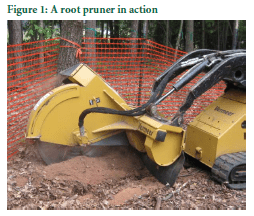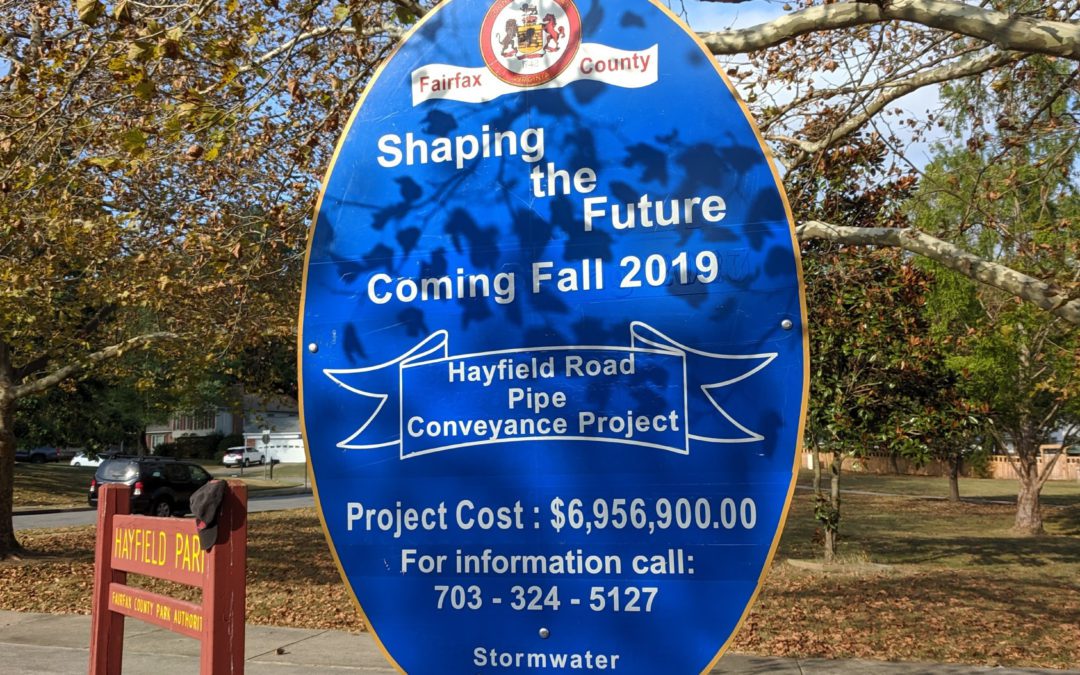RESEARCH LABORATORY TECHNICAL REPORT from Bartlett Tree Experts
Root Pruning
Kelby Fite, PhD, Plant & Environmental Science and E. Thomas Smiley, PhD, Urban Forestry
Root pruning is the process of cutting roots prior to mechanical excavation near a tree. Root pruning may be necessary to minimize damage to the tree’s root system during construction or in preparation for large tree transplanting. Improper root pruning and root damage from excavation can cause great harm to a tree which may affect tree health and/or structural stability. A tree risk assessment should be performed prior to cutting any roots and alternative techniques, such as boring under the roots, should be considered.
Root Pruning Methods
When pruning roots, there are guidelines regarding size: roots less than one inch (2.5 cm) in diameter can easily be cut with hand tools while cutting roots greater  than three inches (7.5cm) in diameter should be avoided whenever possible. There are three general methods of root pruning in the one- to three-inch diameter range:
than three inches (7.5cm) in diameter should be avoided whenever possible. There are three general methods of root pruning in the one- to three-inch diameter range:
- Air/Water/Hand Excavation and Pruning
Excavating roots requires the use of the AirSpade®, hydro excavation or hand tools. This exposure allows the arborist to evaluate the best places to cut, preferably beyond sinker roots or junctions. Roots can be cut most cleanly with a sharp saw or lopper. Exposed fine roots that are to be preserved may be covered with burlap and sprayed with water, or they can be sprayed with a hydrated, fine, water-holding gel to prevent desiccation.
- Root-cutting Machinery
A root pruner, such as the Dosko or Vermeer Root Pruner, is faster than the previous method (Figure 1). These tools have teeth similar to a stump grinder and provide relatively clean root cuts. However, this method does not allow for the arborist to evaluate the exact location of the pruning cuts and will, likewise, be indiscriminate.
- Trencher or Excavator
 A chain trencher or excavator is one of the worst ways to prune roots because they often lift surface roots out of the soil until they break and leave other roots crushed or torn. After using a trencher, it is better to prune the damaged ends by hand than to leave them untreated. Sometimes, due to site constraints, trenchers are the only option due to their flexibility.
A chain trencher or excavator is one of the worst ways to prune roots because they often lift surface roots out of the soil until they break and leave other roots crushed or torn. After using a trencher, it is better to prune the damaged ends by hand than to leave them untreated. Sometimes, due to site constraints, trenchers are the only option due to their flexibility.
Root Cut Placement
The further from the trunk that root cutting occurs, the better, but generally root cuts made outside a normal dripline of a tree rarely cause permanent tree damage. The preferred minimum distance from the trunk to the closest root cut is 5 to 6 times the Diameter at Breast Height (DBH).
For example, with a 12-inch (30 cm) diameter tree, the root cut distance should be 60 to 72 inches (5 to 6 feet, 1.5 to 1.8 m). At this distance, there should be minimal impact on the health or stability of most tree species with proper aftercare.
For root cuts on only one side of a tree, the root cut distance can be somewhat closer to the trunk than cuts on more than one side. The preferred minimum distance in this case is three times the DBH. For example, with a 12-inch (30 cm) diameter tree, the distance would be 36 inches (3 feet, 0.9m) (Figure 2). This distance is too close if there is pavement over the other side of the root system, if the tree has root decay, is leaning or has other indications of root disturbance. These trees also need proper aftercare to reduce the risk of health problems.
In all cases, consider variables such as tree species, age, tree health, and soil characteristics (including the presence of underground root obstructions) when determining location of root pruning. Cuts made closer to the trunk may dramatically compromise stability and health and should be avoided.
Plant Health Care Before and After Root Pruning
Tree health and soil moisture should be monitored frequently following root pruning. Root pruning should not be done immediately prior to or during a drought period unless the tree will have adequate irrigation. Irrigation should be applied prior to and after root pruning if there is not adequate rainfall. Monitor for secondary pests and apply protective treatments to susceptible trees for lethal invaders such as borers. Fertilizer and soil amendments should be applied according to soil or foliar nutrient analysis test results. Root Invigoration should be performed to promote root regeneration and a better environment for remaining roots. At a minimum, mulch should be applied to reduce soil moisture loss and promote root growth.
Founded in 1926, The Bartlett Tree Research Laboratories is the research wing of Bartlett Tree Experts. Scientists here develop guidelines for all of the Company’s services. The Lab also houses a state-of-the-art plant diagnostic clinic and provides vital technical support to Bartlett arborists and field staff.


Recent Comments